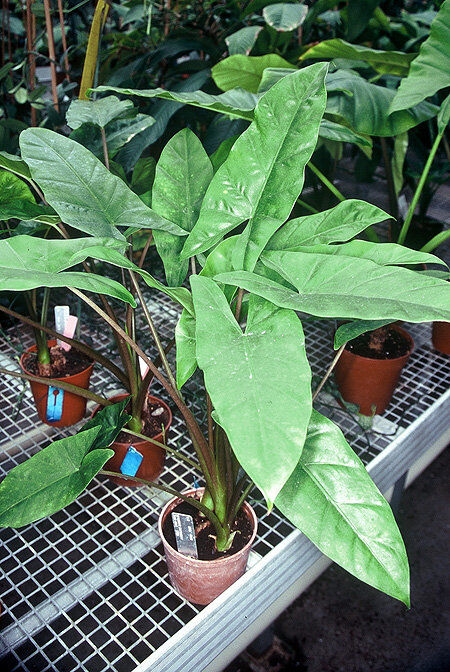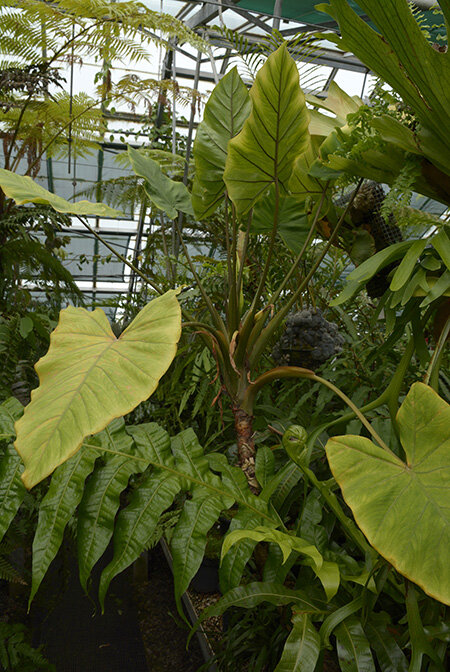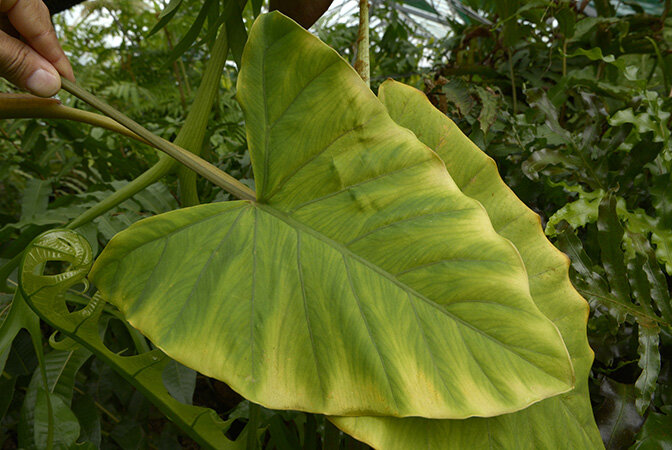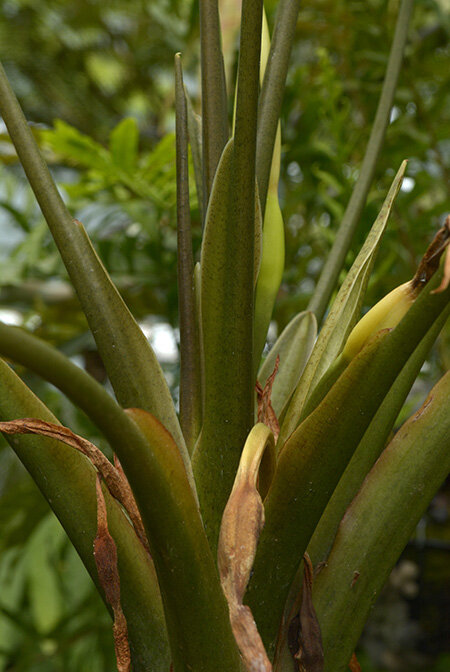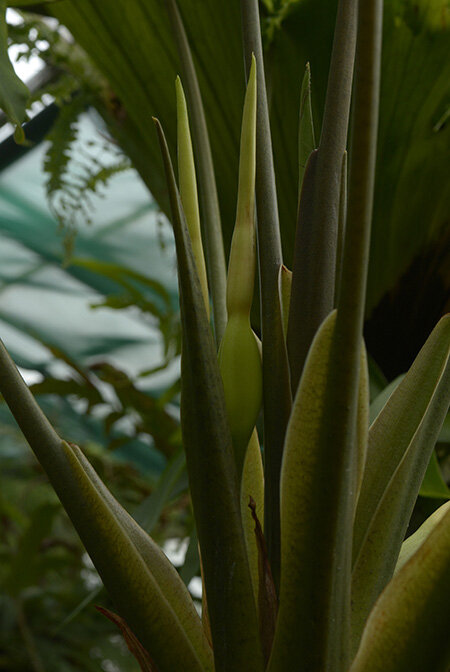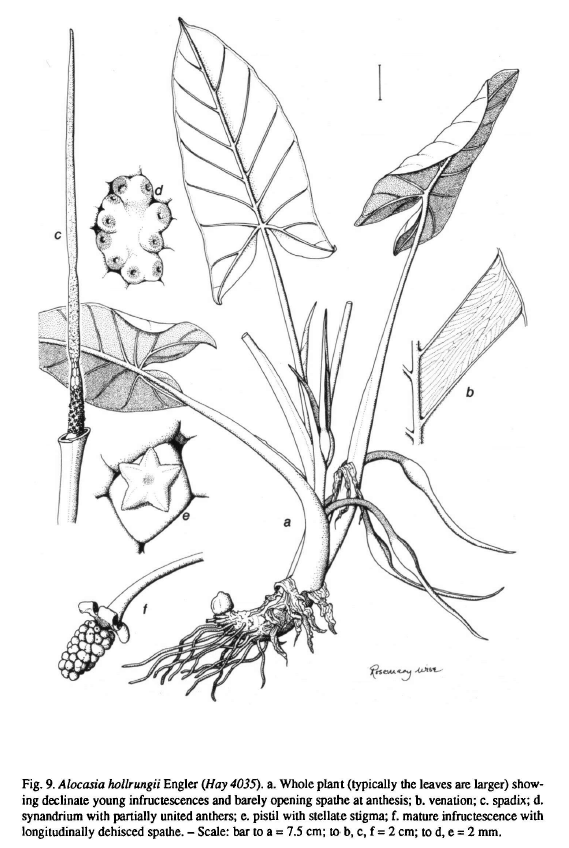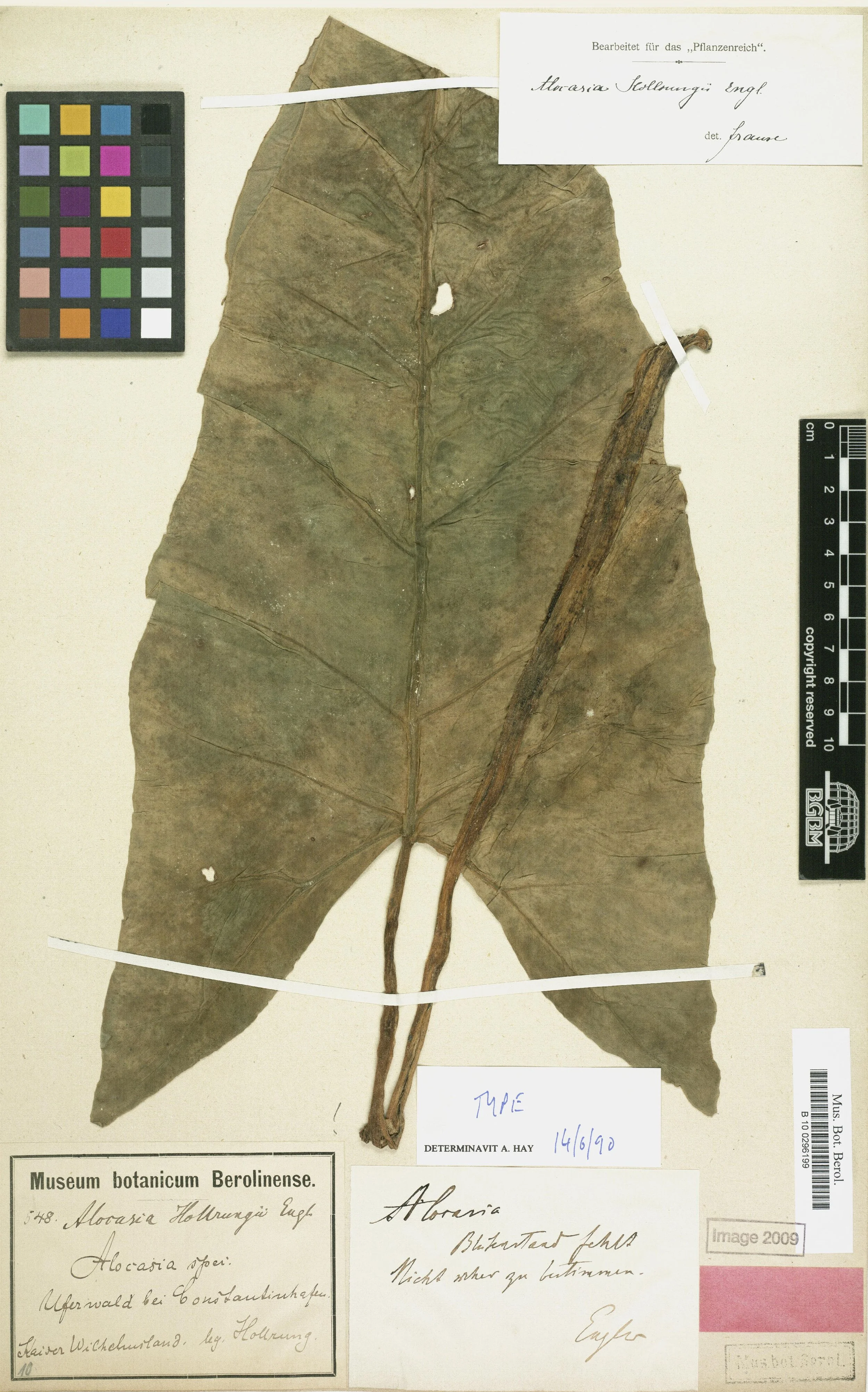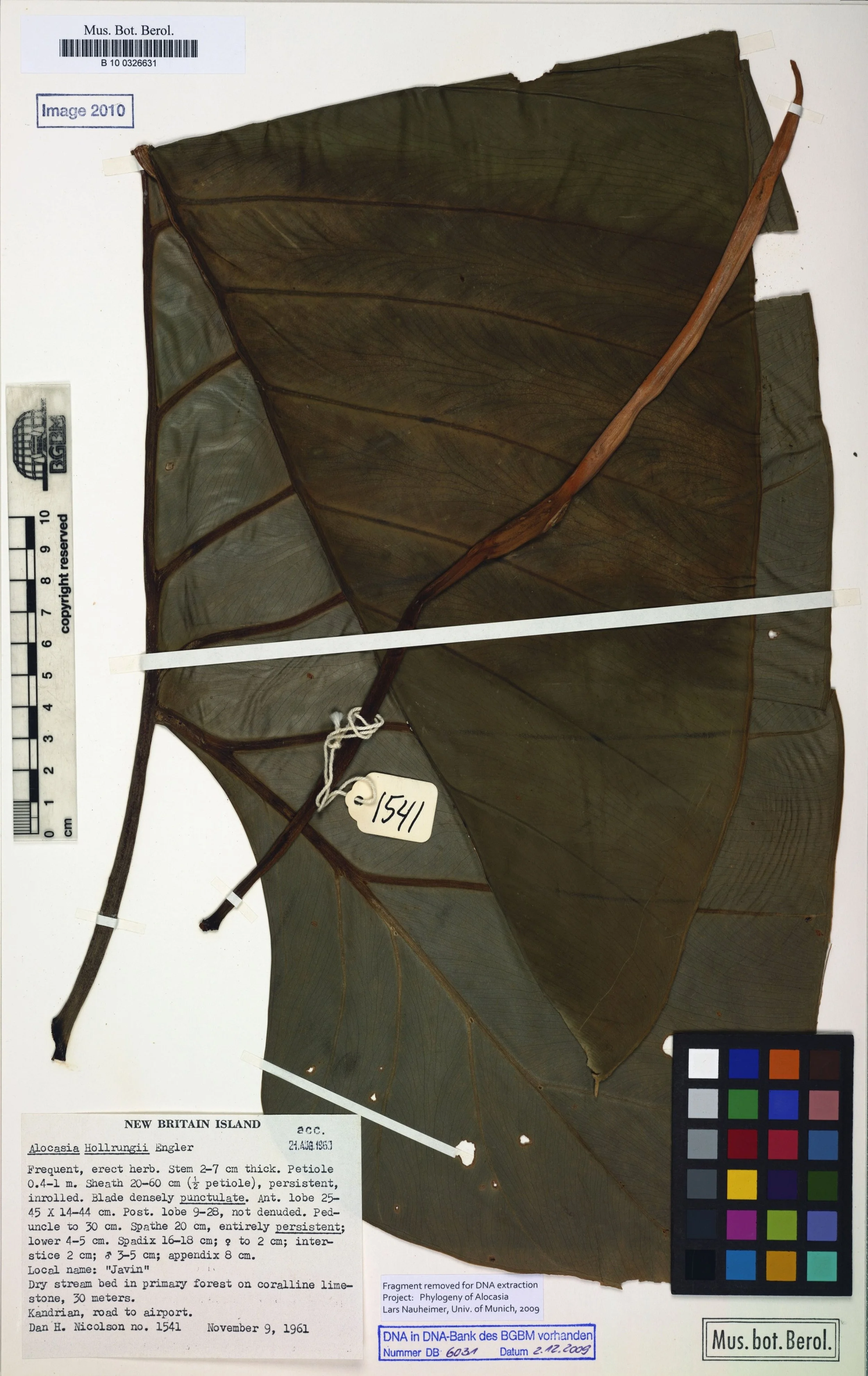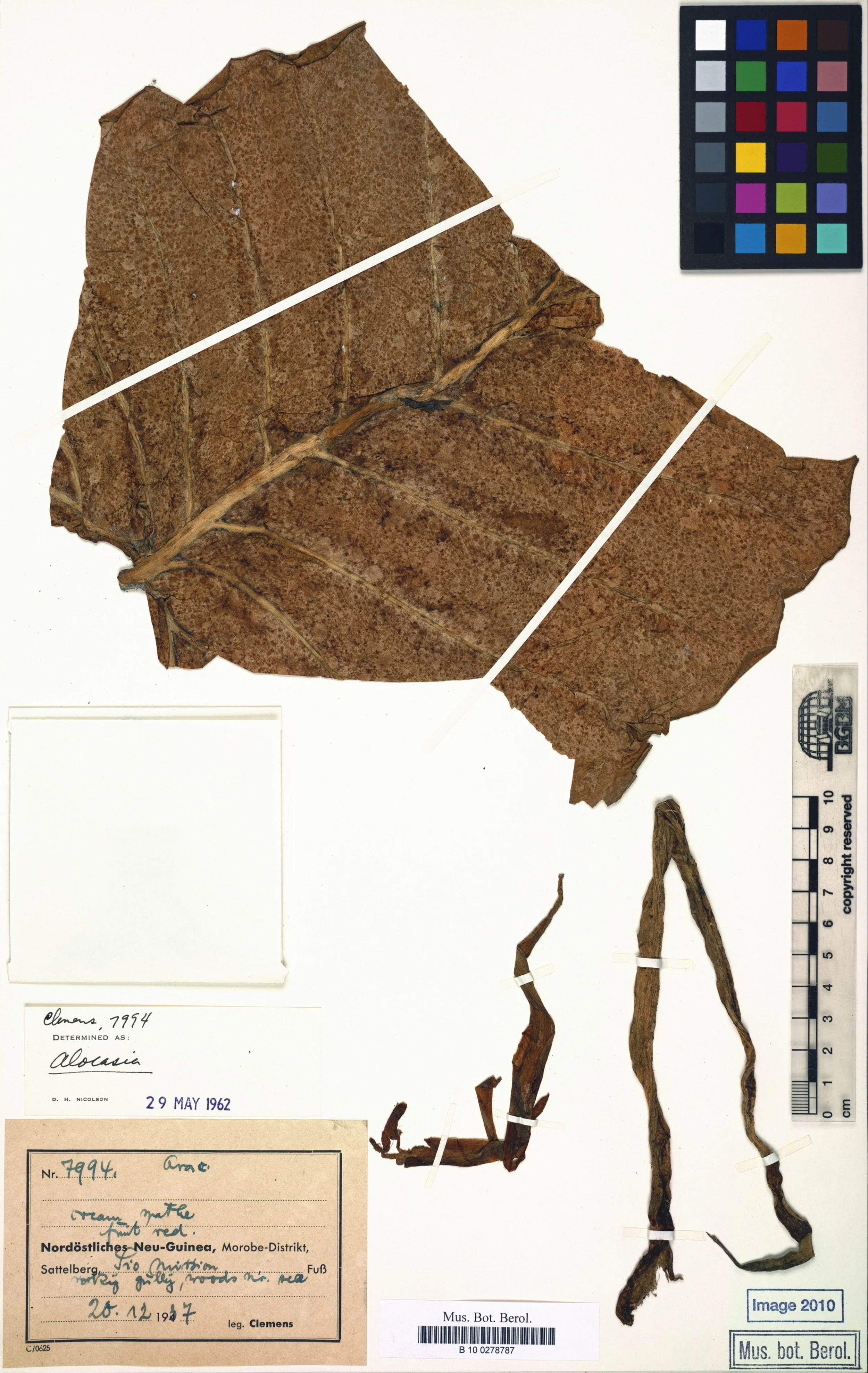ALOCASIA HOLLRUNGII
ORIGINAL DESCRIPTION:
SYNONYMS: N/A
DISTRIBUTION: North East Papua New Guinea, Bismarck Archipelago
Hay has tentatively ascribed a specimen from each of Gulf and Western Provinces of Papua New Guinea to this species. The material is fragmentary, however. Alocasia hollrungii is otherwise not recorded south of the cordillera
CLIMATE: Tropical humid climate
Humidity is moderate throughout the year, ranging from 60% to 70%
Temperature is varies between the seasons - within the range of 48°F/9°C to 88°F/31°C during the day. Minimum temperatures never dip below 45°F/7°C
Rainy and humid season (October to May) and a dry season between June and October. The average annual rainfall is 1,200 mm
ECOLOGY: It is common in the lowlands (but Pullen 1555 from c. 1000 m), in rainforest and forest edge, gaps, regrowth, often an abundant weed in plantations
SPECIES DESCRIPTION:
Rather small to very robust herb; rhizome decumbent, 4-c. 10 cm diam., naked in the older parts, the younger parts with some marcescent remains of leaf bases; leaves about 6 together, very variable in size and shape; petiole c. 90 cm long, rounded abaxially, somewhat flattened adaxially, usually with a ridge running up the middle of the adaxial surface, sheathing in the lower half, green to bronze, rarely purple-black, sometimes pinkish-mottled; wings of sheath persistent, somewhat inturned and closed or nearly closed after the emergence of subsequent leaf; blade narrowly to broadly sagittate, membranous to somewhat leathery, with the margin entire, rarely faintly undulate; anterior lobe to c. 60 cm long, c. 50 cm wide at base, often considerably smaller and sometimes less than half as wide as long, with c. 7 primary veins on either side of the anterior costa, diverging at an angle of 45-60 degrees; primary venation distinctly raised adaxially in robust specimens, prominent below with small flat glands in the axils; posterior costae 1/3rd to 1/2 the length of the anterior, with lamina extending to the sinus; secondary venation flush on both surfaces; interprimary collective veins absent
INFLORESCENCE:
Inflorescences paired, each pair subtended by a cataphyll, the second inflorescence subtended by a small prophyll; peduncle to 25 cm long, not or hardly emerging from the cataphyll at anthesis, held erect, afterwards markedly declinate and exposed; spathe to 22 cm long, very slender, constricted 2-4 cm from the base, the limb opening only level with the male zone of the spadix, persisting after anthesis, ivory to yellowish to pink to red, purple in black-petioled forms; spadix very shortly stipitate, slender, almost as long as the spathe; female zone 1-2 cm long, almost cylindrical, c. 0.6-1.1 cm wide, with c. 60-80 pistils; ovary green, unilocular, pluriovulate; stigma white, stellate, 4- or 5- armed, more or less sessile; ovules anatropous; interstice of sterile organs c. 1.6 cm long, 7 mm long at base, tapering to c. 3 mm, ivory; male zone 4-5 cm long, 5-7 mm wide at base, very gradually tapering into the appendix; synandria ivory, rather to very irregularly shaped, with the anthers free at their sides, opening by apical pores; appendix equalling to double the length of the male zone, ivory, smooth to faintly sulcate, sometimes staminodial in the upper portion, gradually tapering to a point; fruiting spathe splitting into longitudinal recurved segments; berries orange-red, several-seeded; seeds globose, c. 4 mm diam., strophiolate.
VARIEGATED FORMS: N/A
ETYMOLOGY: Named after German botanist Udo Max Hollrung
NOTES: There may be some regional variation, but it is not yet well enough understood for nomenclatural recognition to be useful. Generally the plants in Morobe Province are less robust than elsewhere and occur commonly in rainforest undergrowth. In other parts of the range the plants are often more robust and tend to occur in more open sites. Reddish colouration in the spathe occurs towards the western end of the range, mixed in populations with pale spathes. Likewise, bronze and reddish pink coloration in the petiole and major venation occurs mixed in populations with pale green petioles and veins. Occasional individualshave blackish purple petioles and veins and green laminas, similar to some cultivars of A. macrorrhizos. The two figures cited above in Burnett (I.e.) represent the extremes of form within the species. The peduncle declinate after anthesis is highly characteristic. The spathe limb persists for some considerable time after anthesis, eventually rotting and falling away shortly before the lower part dehisces.
Other specimens seen:
PAPUA NEW GUINEA. Oomsis, Brass 29208 (LAE); Wewak, along trail beyond Boys' Town reform school, Croat 52751 (LAE); Sankwep, SE of Lae, Croat 52810 (LAE); nr Marok Village, Ailape, Darbyshire & Hoogland 7916 (CANB); 30 km from Vanimo along Bewani road, Hay V29 (A, LAE); nr Dami, Kimbe, West New Britain, Hay 1300 (LAE); nr Baku, Gogol Valley, Hay 4003 (NSW); Wasab, Hay 4017, 4035, 4036, 4037 (all NSW); c. 30 km from Madang on North Coast road, Hay 4038 (NSW); East Sepik Prov., 41 km WSW of Nuku, Heyligers 1624 (CANB); 50 km NE of Nigerum, Western Prov., Hyn 192 (LAE); Iafar, NW of Amanab, West Sepik, Juillerat 183 (LAE); Hopu R., Lae, LAE 51932 (L, LAE, US); Sepik, Ledermann 6639, 6885 (K); Malalia, nr Cape Hoskins, NGF 6518 (K, LAE); Saidor, SE of Madang, NGF 6895 (A, BRI, LAE), NGF 6896 (BRI); Aiwit R., E of Fullerborn Harbour, East New Britain, NGF 14985 (LAE, US); West Sepik Prov., Vanimo, Ossima, NGF 39193 (BRI); Vunapaladir, Keravat, Kokopo, East New Britain, NGF 44363 (LAE, US); cult. Lae botanic garden, Nicolson 1394 (K, LAE); Bumbu R., 7 mi N of Lae, Nicolson 1407 (LAE); Malambe Track up Busu R., Nicolson 1455 (BO, US), 1456 (L); East New Britain, 25 mi W of Rabaul, Kcrcvat road, Nicolson 1493 (L, LAE, US); Kandrian, West New Britain, Nicolson 1541 (BO, L, LAE); Madang Airport, Nicolson 1558 (LAE); Gumboak Stream, between Gwabadik and Gawan, Busu R., nr Lae, Okada & Katik 4326 (BRI); Maprik, Mt Turu, on Ambakanja-Wainjo track, Pullen 1555 (CANB, LAE); Kokopo, van Royen 6616 (LAE); Gulf Prov., Purari R., nr Uraru village, Schiefenhdvel 98 (L); Ambunti, Townsend 154 (LAE).
CULTIVARS: N/A
HYBRIDS: N/A

